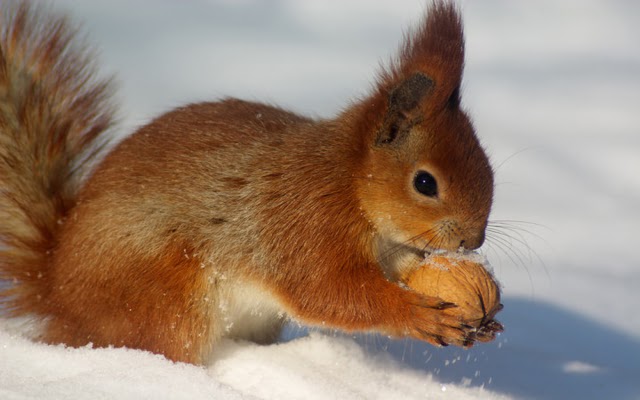
Have you ever noticed that animals don’t go grocery shopping? When you want peanuts, you go to the store. When squirrels want nuts, they find them in trees.
Going to grocery stores is convenient for us. They always have a wide variety of food options and are open all year round.
During winter, you don’t have to stock up on food to eat when it’s cold outside. You can simply go to the store whenever you need more food.
However, for many animals, the “store” is not open all year round. For example, many plants and trees only produce edible products like fruits and nuts at certain times of the year. If animals want to have enough food to survive winter, they often need to save some for later.
One animal that you may have seen saving nuts for winter is the squirrel. That’s why some people refer to saving up food for winter as “squirreling” away food.
Not all squirrels save food in the same way though. Gray and Fox Squirrels, for instance, hide their food by burying it in various places underground. Scientists call this “scatter hoarding.”
Why do they do this? It’s actually a clever thing to do! If another animal finds a stash of food and eats it, the squirrel will still have many other stashes of food and won’t go hungry.
On the other hand, Red and Pine Squirrels hide their food in piles. They dig shallow pits, called middens, and cover them with leaves or other ground cover. Scientists refer to this as “larder hoarding.”
Squirrels are not the only animals that save food for winter. Wildcats often bury small prey, such as birds. Moles save up earthworms in mounds. Foxes might store eggs or bones in shallow holes. Mice scatter hoard seeds and nuts in underground nests.
When squirrels and other animals scatter hoard food for winter, how do they know where to find it again? Some experts believe they don’t necessarily remember where they hid their food. Instead, they rely on their sense of smell to locate buried food.
Others believe that animals do remember where they buried their food. They might use landmarks, such as trees and plants, to help them remember where they stored their food.
Some squirrels even play tricks when hiding their food. Scientists have discovered that some squirrels bury fake nuts. They dig holes but don’t actually bury anything in them. They pretend to have buried something there in order to deceive other animals!
Give It a Try
Are you prepared for winter? Make sure to try out the following activities with a friend or family member:
Preparing for a Food Shortage
Think about the meals you consume daily. Now, envision a scenario where all local grocery stores are about to shut down for three months in just a few days. What actions would you take? How would you go about selecting the essential items to stock up on? Utilize this Canva template to create a collage of the foods you would want to have at home during this situation.
Exploring Squirrel Behavior
If you have trees in your backyard, spend some time outdoors today. If not, locate a nearby wooded area that you could walk to and enjoy for a little while. Reflect on the squirrels that inhabit the trees. If you were a squirrel and needed to gather nuts to sustain yourself during the winter, where would you store them? Examine the various possibilities around you. Would you recommend scatter hoarding or larder hoarding? What are the advantages and disadvantages of each method? Share your thoughts with a friend or family member. Do they agree with your perspectives?
The Importance of Saving for the Future
Although we don’t need to hoard food for the winter like squirrels do, individuals do set aside certain resources for the future. One of the most crucial things we save for the future is money. If you think ahead, you can easily identify numerous things you might need money for someday: new clothes and shoes, a bicycle, a car, and even college! Initiating a savings account at an early stage also enables you to maximize the benefits of compound interest from the bank. So start setting aside some money and watch it multiply and grow over the years. For more information on saving money, visit the Project C.H.A.N.G.E. Dreaming Big website to learn about effective future planning.
Wonder Sources
- http://www.discoverwildlife.com/british-wildlife/how-identify-animal-food-stores
- http://www.ncbi.nlm.nih.gov/pmc/articles/PMC2830248/
- http://www.backyardnature.com/cgi-bin/gt/tpl.h,content=501





Leave a Reply